The interesting engineering behind the SHAPE of Train wheels!
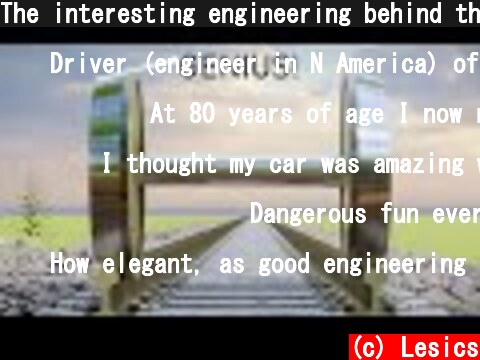
(c) Lesics Have you ever wondered why the train wheel shape is conical, not straight. Let’s explore this simple, but genius invention in detail.
Driver (engineer in N America) of 40 years here. I’ve had to explain this to several trainees over the years and none of them had any clue of this phenomenon before it was explained to them. It’s just not something the average person wonders about. I also explained (not to criticise as your video is excellent but you probably should’ve too) that the further apart the wheels are (the wider the track gauge is) the more differential action is needed because the outside wheel has to travel a LONG way more than the inside wheel but train wheels and the rails they run on are only around 80mm (3″) wide so the wider the gauge, the less tight of a curve the train can negotiate. That’s why mountain railways are often narrow gauge. Narrow gauge is cheaper to build than standard or broad gauge and when people are told that, they always say “because the sleepers (ties) are shorter?”. Well, short sleepers probably are cheaper than longer ones especially when you need thousands of them but narrow gauge is cheaper because you can go around mountains rather than having to tunnel through them because you can’t negotiate tight curves.
At 80 years of age I now realise that “YOU ARE NEVER OLD ENOUGH TO LEARN” !!. hehehe
I thought my car was amazing when I found out in highschool how this was achieved. Now I’m blown away from this. I realized what it did immediately as soon as I saw the (larger/smaller) contact surface area on the track.Totally don’t understand why my shop teacher didn’t use this as another example of how it works. Nice video, appreciate the learning and lesson in less than 5 minutes.
Dangerous fun ever in history 2:25 btw out of fun (Not your kind of 😂 ) Your explanation through amazing graphics shows your pure dedication towards your work ,Thanks Sir!
How elegant, as good engineering should be! Solving huge engineering problems using just simple geometry. No gears, extra shafts, or separate machines or control electronics. The engineers were like, “Just add a taper and we’re good.” 😂
I had never considered the necessity of differential action when a train turns a corner, this explained it very neatly and the animation was excellent nice and clear. Thank you very much.
Brilliant video! Something I had never given any thought to before, but this was presented in a simple, yet informative manner. Amazing how something like a shape of a wheel can be so intelligently designed yet taken for granted.
This is such a cool video! Educational, while still being easy to understand, and visually appealing, without losing the basis of the content. I love it and I can’t wait to watch more
Yeah, train wheels are the perfect example of keeping things simple, no need for expensive over-engineering and complex mechanical parts. Very simple but very clever.
In some technologically left behind train systems (Romania) the wheels have two caps one on the inside one on the outside. I have never seen this model before but looks like its more efficient to produce and will help the train consume less. Such a simple and great invention!
I have seen lots of train wheels, but never looked close enough to see the taper. Makes perfect sense! I always assumed that it was just the flange that kept the train on the tracks.
I have never even thought about how the wheels of a train work. I had no clue there would be this much thinking and calculating, involved with designing those simpel metal wheels. Great explanation 👍
Intuitive explanations and gorgeous animations! We need more creators like you
This self-centering sounds similar to the way dihedral wings self-level the plane when it tips–vectors and perpendicular angles.
Intuitive explanations and gorgeous animations! We need more creators like you
I never thought of how conical wheels could compensate for different lengths of travel when rolling around a corner. I just assumed each wheel rolled independently and wasn’t firmly attached to an axle. But now that I think about it more, having the wheels firmly attached to axles means the same differential action caused by the conical shape would also cause the wheels to _actively steer_ back to the center of the track if the wheels were shifted off-center. That’s brilliant.
Coning of wheels helps to prevent shock loads to the sides of the rails, to prevent unequal distribution of loads on rails, and also to reduce the wear and tear of the wheel flanges and rails.
Never thought about this before. Never really cared to know. Now that I know, it’s a fascinating piece of “useless trivia” to have at my disposal for party chit-chat. Thanks for the great & clear explanation! 👍🏻😎👍🏻
As an engineer, simple but effective design like this is what I live for. This is freaking beautiful.
Intuitive explanations and gorgeous animations! We need more creators like you
Airbags | How do they work?
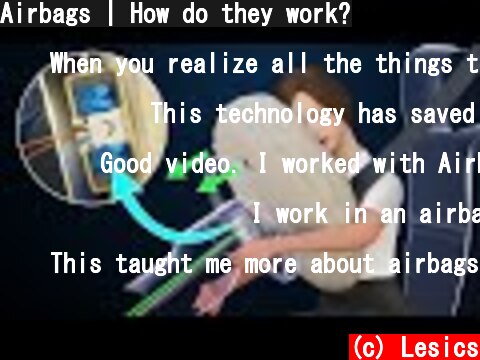
(c) Lesics The engineering behind the airbags is pretty amazing. Let’s explore how do they work in detail. Be our supporter or contributor: …
When you realize all the things that happen when the airbag deploys, it’s just insane how fast it all works.
This technology has saved my life two times. Thank you for such an informative lesson on this feat of engineering!
Good video. I worked with Airbag and Seat belt and Seating systems years ago. I didn’t notice anything wrong with your presentation. Additional things you could have mentioned are: seat belt pretensioners that deploy before the airbag to make sure the seat belt is correctly tensioned, and that the passenger seat sensor determines whether to deploy the passenger airbags (specifically). A good idea is to link to your seat belt video at the end because Youtube’s algorithm might not.
I work in an airbag and seatbelt factory here in the philippines, the work is very meticulous, the sewing needs good quality for everyone’s safety.
This taught me more about airbags than did my automotive class. I was only taught how the circuit works but not how the airbag is actually deployed with the chemicals.
3:30 someone crashed into a tree nearby but these 2 guys just do their buisness, that is some dedication to the job.
This invention is literally a life saver. Kudos to the people who made this.
I am in favor of airbags, when you have your seatbelts on. As a retired firefighter I’ve seen them save lives many times. However I will never forget the Thanksgiving two cars just bumped corners (not even enough to destroy the lights) and the passenger airbag deployed. There was an unrestrained 5 year old girl in the seat who had bent over to pick up a toy in the floor board. She was hit full force, inches away and died instantly. Probably the single most horrific thing I have witnessed. Airbags are great when used properly, please make sure everyone has on their seatbelts!
Really good no nonsense informative videos you present. No bogus introduction and subscribe drama at the beginning, but straight to the point. It’s really impressive and important how clearly and simply you explain things, and in a progressive manner. Kudos!!
There was an incident in which a family didn’t know about the seat belt’s need for the activation of airbags, and sadly they died from the crash, there family registered a complaint against the car company thinking it was a manufacturing error, and they never reached anywhere as the necessity of seat belt was common for every model and is explained in the manuals. They bought the car for the exact reason of airbags yet it never helped them in time of need, because of lack of intel and taking safety measures too lightly.The point is, if you dont follow the guidelines for safety, non other will be responsible for your damage and you will have to suffer it painfully…
My mom had an accident a few years ago with a Hyundai (5 seats) car.The airbag didn’t open even if it was armed but compared to a normal accident she was hit in the back-side of the car by another car at around 75 km/h while she was taking a right corner (so she had relatively very slow speed herself making the impact force IMENSE.She got a head injury but was better in a few weeks.The reason for the airbag failure might be due to the car being hit in the back not in the front where most sensors are.
Well done – I learned a lot about airbags! thanks for posting
Your animation is quite good, quite easy to understand even for people from non scientific background. And for me, a science student it is absolutely enjoyable
speaking of potholes, I used to be scared of airbags deploying just because of potholes. and eventually, just in 2019, I ran into a very deep pothole one night and thankfully the airbag didn’t deploy. the dashcam came off from the windshield though and I bit my tongue lol. at least now I have peace of mind that airbags don’t usually deploy just because of deep potholes 😄
This brought back memories of my first job in the automation industry back in the 80s. I worked at a company, Advance Automation Systems Corporation, in Simi Valley, where we made three automated production machines for AT&T, so that they could produce the magnetic ball switch for these systems.The assembly went through a final continuity (Ohms) test for the contacts and the magnetic field (Gauss) was verified as well.
Fantastic video! Loved to know the evolution of airbags.Once an airbag exploded in my face, i was copilot and i the crash caught me off guard, i was slightly leaning forward and the airbag slapped my face. It was like a hand slaping my face at 320km/h.
Truly amazing tech and when all the components of the system are realized and you see just how much is taken into examination, it’s jaw dropping. And yet, it’s ‘just another feature’ we expect in cars.Prime example of an underdog/unsung hero.Also, I’d like to point out that these people should probably have their license revoked… They keep driving I to boulders in the middle of the road… Just sayin’.
Great video but you’ve actually got a few things wrong in this one!The Takata recall was due to them using Ammonium Nitrate NOT Sodium Azide as they swapped to a cheaper material while most Inflator Manufacturers were trying to distance themselves from Sodium Azide due to its toxicity. It is Ammonium Nitrate’s sensitivity to temperature changes and moisture that caused Takata inflators to rupture which is also why ruptures are more common in more humid areas.
It’s still mortal though depending on the speed of the vehicle, a man recently died in an accident in my place last December cuz the airbag pressure on his face was high even though he had his sit belt put on ,he face was partially damaged and he died instantly, so folks who overspeed , air bags are good but doesn’t guarantee 💯 security, Don’t drive too fast
Me and my mom were in a crash on Aug. 13, 2021. We were ni a 2008 Cadillac CTS. We called it the “Black car”. We were headed down street not even a quarter mile from home. A drunk driver hit us on the side at 80. The airbags were powerful enough to make me and my mom go deaf for a short time. If it was any closer to any of the doors we would have flipped over.
Jet Engine, How it works ?
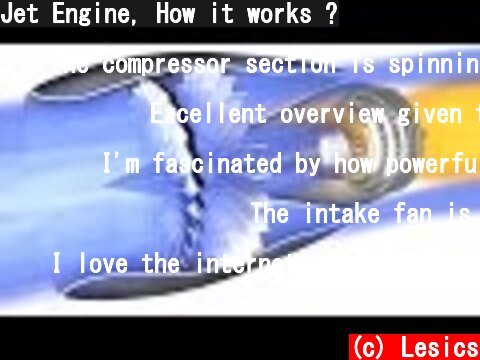
(c) Lesics Help us to make future videos for you. Make LE’s efforts sustainable. Please support us at Patreon …
The compressor section is spinning the wrong way, but you have the turbine section going the correct way, but the turbine is missing the first stage nozzles. If you go through this much trouble to make an animation shouldn’t you at the very least have it vetted by someone to ensure you haven’t made an obvious error?
Excellent overview given the lenght of the video! A key point that wasn�t stressed enough imho, is the trade-off between speed and fuel consumption that turbo-fans come down to. That solution is at the very center of the economics of aircraft industry. Turbo fans don�t accelrate air as much as a turbo jet does but achieve the needed thrust by moving more air mass in comparison, thanks to a much larger diameter of the fan. The Trust is obtained by multiplying the air flow (kg/s) by the speed gradient. Given the same thrust a turbo fun allows for a smaller turbo-jet component which result in lower compsuntion at the expenses of speed at the noozle.
I’m fascinated by how powerful and organised these massive machines are and what sucking power they produce and what output(so Powerful) it produces and we normally say it’s a aeroplane nothing big!
The intake fan is rotating backwards in the animation. At a minimum the intake fan will have be going forward for it to work.
I love the internet.I get curious about jet engines and 10 minutes later I roughly know how they work
Stumbled across this channel and it is now my fav channel on all media platforms. Great explanations on so many amazing engineering devices! Thank you for creating this channel and it’s content.
This is a GREAT explanation. Finally I get the grasp of the concept. Thank you.
Airplanes fly by flapping their wings.
Wow… Thank you for your clear and simple explanation of how a jet engine works
I actually learned about turbine engines in the 3rd Grade! I’m not sure how, but our Teacher was very knowledgeable about them! She explained turbojets, turbofans and turboprops!
This video would benefit a lot from 1.) a treatment of fluid dynamics and how the air is actually compressed, and of 2.) of the chemistry/stoichiometry of combustion. In other others, how and why is the air actually compressed.
To cut a long story short, the answer is magic.
This is probably the most amazing intriguing invention that attracts most ppl’s exploring minds trying to understand how it really really works over that century!!
Very well made video! We have used this very to great success with high school students who enjoyed learning the concept without much stress
Thank you, best video giving the idea up to now, perfect words just in time and gives power to dull and hard to do also very time consuming and missing and unrealistic animations of earth. Even just slides step by step can make data flow much faster. Animations of any kind of field that are prepared in very pro manner in that field firms must be shared to use here and there for children and youth. Just like electronic part models of all producers. Thus less people serve much more animation of different subjects and contentsof educative lines really shine.
Great job. Could have cover why low bypass turbo fan supersedes turbo jet in supersonic flights.
They never state how the engines are started. In order for this scenario to work it most likely requires the turbines to be turning, forcing air through the system prior to fuel ignition or it would just sit there and burn fuel and the plane since it is an open system allowing pressure to escape in both directions without help.
Fantastic!! This is an awesome channel for non-engineers like me to learn *how stuff works*. Keep up the good work!!
All gas turbines of different types depend in their work on drawing air from the outside and then increasing its pressure and speed with condensers to tens of atmospheric pressure according to the number of feather discs so that the friction between the compressed air particles with each other inside the condensers increases, which raises the temperature of the compressed air to times the boiling point of water to accelerate the combustion of the fuel spray coming out of the syringes in the combustion chamber, which increases the efficiency and concentration of the directed kinetic energy resulting from the combustion, so that the combustion product acts as a counterfeed by moving the exhaust blade discs connected to the same axis of the compressor discs, and in the event that the concentrated air pressure inside the condensers is disturbed, the energy produced in the combustion chamber they will be dispersed to all directions and may cause an explosion inside the gas turbine. This is why the margin of error during manufacture of the turbine disc blades does not exceed several microns to maintain the stability of the flow of compressed air inside the condenser.
Thank you! Well described and illustrated!
Why you should not PARTIALLY press the Clutch ?

(c) Lesics In manual transmission cars, some drivers partially press down on the clutch pedal to make the engine operate more smoothly.
This is extremely accurate. The BMW driver is in two lanes at once AND he’s not using his blinker in any given scenario.
I remember continuously asking my driving instructor how the clutch worked and he would always make me feel stupid for not understanding his answers. Now, actually seeing how it works, I realise he had no clue himself and was either too stupid or too much of an asshole to recognise that. Probably both.Thanks for explaining
You are definitely going to use partial clutch on atleast two occasions in a manual gear box car. When you start off from rest to avoid wheel slip and stalling and also during up hill start as you release the hand brake (unless you have an uphill hold function).
5:00For those looking to skip all the fluff and get to the point of the video.Partially pressing clutch causes friction disk wear.Extra detail: you’re probably already driving as best as you can. Cars suffer wear and tear. Get your car serviced regularly and properly, and you’ll be fine.
You can also avoid riding the clutch while leaving a stop light by revving the engine dumping the clutch and doing a burnout
Having driven professionally for almost a decade, it’s virtually impossible or at the very least impractical to never keep the clutch partially depressed. Just don’t overdo it, regularly service the car, and everything will be fine. You’re not likely to own/drive the car for as long as it would take in order to break it purely because of partially depressing the clutch.
I’ve found a way to save my clutch. 0 wear and tear. I simply dont shift. I leave it in 1st…… on an unrelated note, the smoke coming from under the hood, and that knocking sound… both normal right?
I found out about this negative effect of riding the clutch one day while stopped on an uphill slope in traffic. Instead of disengaging the clutch and using the brakes to stop and remain in place, which would then require me to engage first gear to get going once traffic started moving, one day I just rode the clutch to keep the car in balance between going forward or letting gravity take me down the hill in reverse and into the traffic behind me. I did this for many minutes because of the heavy traffic and suddenly my car started to smoke inside the cabin and it smelled of burning brakes, which in effect was my clutch burning up. After realizing that my clutch was getting damaged I immediately stopped riding the clutch and haven’t done it since, except for some occasions where it is very momentary. It is definitely a bad idea to ride the clutch frequently and especially for extended periods of time. Lastly, it is possible to shift gears without using the clutch on many vehicles including motorcycles if you know your vehicle and know how to feel the engine revs and then time the shift precisely.
My engine sometimes skips a beat when driving off, so I depress the clutch a bit so it can slip when it misfires.On rare occasions when overtaking, I let it slip to get higher revs resulting in more net torque at the wheels. Letting it go gradually after adds the extra energy of the flywheel.I have a tiny car with a tiny engine, so it’s second nature.
Guys I’ve eliminated riding the clutch completely from my driving habits. Now, every time my light turns green, I either launch forward or stall. I live near a steep hill that gets heavy traffic due to the stop sign at the top, so I’m constantly launching forward into cars. It’s ok they’re used to me now and applaud my ability to not ride the clutch.
I love how this video explains more than just about not pressing the clutch pedal
The only real risk of damage from depressing the clutch halfway is when you do it for too long or too often. It can overheat the flywheel, friction disk and pressure plate, which can create hotspots, excessive wear, weakening of the metals, and even warping. You should only really ride the clutch in first gear, when youre climbing a steep hill in traffic, per say. You ride the clutch while giving some throttle and youll be able to keep up with traffic without constantly doing hill starts. Usually dont do it for more than a minute, though.
Well the friction material will not wear on low loads when resting your foot on the clutch, but the throwout bearing sure will. I think this is the more important takeaway as to why you should not rest your foot on the clutch.
This make me appreciate hill start assist so much more. When I first got that feature I was a bit frustrated as I was used to revving it quickly between releasing brakes and releasing clutch, when doing a hill start. But with hill start assist, the computer holds the brakes for you until the clutch engages, hence no need to rev too high. But if you rev high anyways it would result in a lurch. I got used to the system quickly and can start uphill as smooth as an automatic.
Well, there are basically two scenarios where partially engaging the clutch (clutch control) is just necessary:1. pulling off in 1st gear of course, you have to partially engage the clutch in order to make it easier for the engine to move the car and not to stall, and as soon as you reach walking speed you may fully release the clutch;2. Driving at very slow speeds is just impossible whilst the clutch is fully released, like moving slowly in traffic jams, and moving slowly while parking.Other than those two I can’t see any other situation where riding the clutch may come in hand.
Guilty as charged, I destroyed two clutches like that, granted I mostly drive in bumper to bumper stop-and-go traffic so riding the clutch is hard to avoid. Anyway, I wised up and switched to automatic, no more cramps in left foot from constant gear changing.
There’s some cars that will stall the engine entirely if you immediately release the clutch fully when taking off from a hill. For smooth shifting you can’t be that abrupt
I always thought it would damage the splined coupling when only half pushing the clutch.
This only really applies for plains areas. In hilly areas where traffic jams occur on slopes, and every road either goes up or down you’re forced to ride the clutch all the time. You literally cannot drive a car in these areas without doing so. Clutch plates get burned out quick but that’s just an associated cost with driving in areas like these.
“…you have to shift to a lower gear.” _shifts from 4th to 1st_
Understanding Anti-lock Braking System (ABS) !
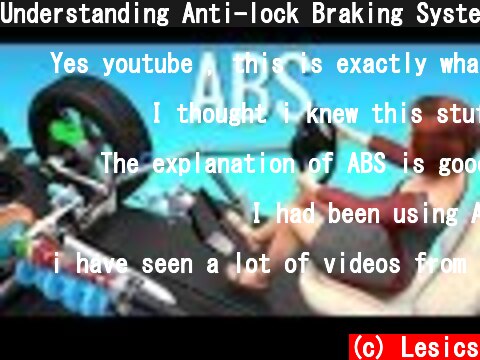
(c) Lesics Nowadays an anti lock braking system is used in almost all modern vehicles. This system prevents accidents like this, where you …
Yes youtube , this is exactly what i meant when i searched for abs.
I thought i knew this stuff, but you guys managed to provide a MUCH deeper understanding of ABS then i had imagined. Under 7 minutes!! Wow! Keep up the good work!
The explanation of ABS is good. However, at 6:15 what is being referred to as EBD (Electronic Braking Distribution) is in fact not EBD. That is ESC (Electronic Stability Control) or a sub-function of ESC. EBD (actually Electronic Braketorque/Brakeforce Distrubution) distributes the brakeforce between front axle and rear axle. EBD does not counteract yawrate.
I had been using ABS EBED since many years without knowing how it works on the road. Thanks for your video lesson. Hope to see you soon with another great video. Thank you.
i have seen a lot of videos from learn engineering all the them were very good, somehow i feel this one was slightly complicated by using the velocity concepts while it could have been explained in a much simpler way.. Although the complication was definitely simplified due to the visuals 🙂 but a big thanks to these videos anyway!!
This classic-style type of A/V presentation is always more effective in delivering information efficiently. It reminds me of Chevrolet’s old video tapes! *Great Job*
Can I just say, this made my driving theory test so much easier, it helped me understand so many questions, and I don’t know if I’d have passed without it, so thank you SO MUCH!
This video really helped me because automobile engineering is a subject in my school and some of the things our teacher taught were unclear, but after watching this video, I understood it a lot better. Also, my exams are coming soon and this video helped me to recall my memory. So wish me luck!
In my country since long before abs was introduced we were asked to repeat pump the brake quickly for better grip, now I understand why
Good video, I was hoping to understand how ABS systems work. How is the intermittent rotation achieved?
Best man …..the best explanation 👍👍👍👍👍👍👍👍👍 very very informative….I hate mechanics specially rotational motion (during my 11th )…but your videos are building an intrest in me toward taking mechanical engineering in future….Thanks a lot man…👍👍👍🙏🙏
Actually, I would explain one part of the video differently (sorry for my imperfect English in advance). Static friction on same contacting surfaces is much higher then sliding friction, that is why, for example, its harder to start sliding sofa then keep it sliding when pushing, it feels like its sticked to the floor. Here, when wheels are rolling, they have static friction with ground, ABS, as explained in the video, prevents wheels from locking and by this, it allows us to keep maximum friction with the ground to reduce braking distance. Great video overall ^^
Awesome explanation and video! I learned in Physics before ABS became a standard item in most vehicles that rolling to a stop is better than locking your brakes to avoid skidding. That meant pumping your brakes about 60 times per second. Lucky there’s ABS! Thank you very much Dr. Kyle and Sabine.
Basically, how much force the wheel and surface can add to the car defines how fast the car stops.When a wheel its not slipping, it’s able to deliver more force than when it is slipping.
You can test this system really easy in winter with the shiny slick snow ice surface. Hit the brakes hard and you’ll hear the ABS pump go to work and the brake pedal will pulsate. It’s kinda fun to do in a safe area and this system really works I can’t believe cars were made without this system
The ABS actually increases the braking distance compared to braking perfectly with ABS off. However, it is very difficult to achieve and requires practise, not to mention the fact that ABS makes it easier to steer properly while braking. In the end I think ABS is a fair tradeoff between braking distance and steering capability.
Simply explained. Even non engineering minds can benefit a lot from this. Thank u so much
Very informative and educated, im always have many question for the ABS glad that been answer and i now understand how it work🙏 Thank you
God dammit. At 3:20 the braking sounds sounded so real in my headphones that I thought they were coming from outside on the road.
I am learning a lot. Thank you so much. I have a request for you. How do traction and four wheel and all wheel drive systems work?
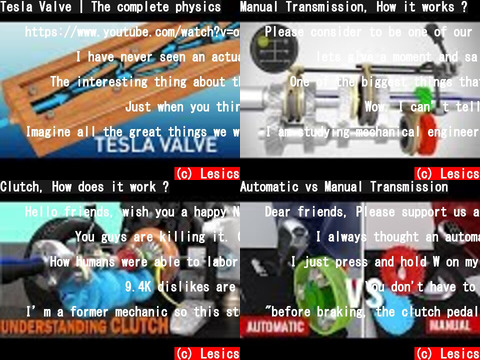













![岡田斗司夫 [切り抜き] 編集ちゃんねる(Youtube 動画 pick up)](https://imitoha.com/c/imgc/UCwfyW7i8kAFUj8_tSSDT_PA/-a-input.jpg)






](https://imitoha.com/c/imgc/UCSEVmNAvs5-8OdkKxyp8AWA/-a-input.jpg)


コメント